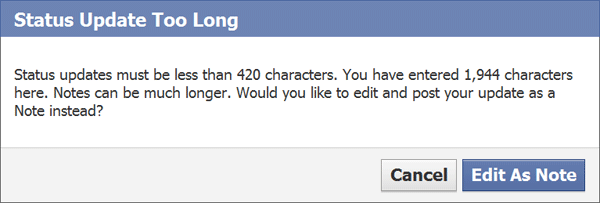Overcoming the 420-character limit for Facebook status updates
If you attempt to post a Facebook status update with more than 420 characters, you will receive an error message like this:

Most people then condense their update and try to post it again, but since Facebook is too busy dreaming up ways to compromise our privacy, they never found enough time to include a character counter. Result? You may get the same error message repeatedly as you guess whether your message is below that needlessly arbitrary threshold. After a few such error messages, you may feel like pulling your hair out!

There is an easy way to bypass this 420-character limit. Facebook won't tell you about it, but I will. Before posting your text, click the link (red arrow) to share a photo.

After that, you are not limited to 420 characters, so you can smile!

As a computer programmer, I know there is no logical reason why you should be forced to post a photo or other image to bypass the 420-character limit. However, as a doctor, I suspect that Facebook programmers have cobwebs in their minds that catch flies with some really strange ideas.
What if you don't feel like searching for a photo to post? Or what if you don't want an image to appear? Trick Facebook by uploading this magic dummy photo (below), which is just a 20-pixel square white image in the GIF format.
Save that image onto your hard drive by RIGHT-clicking it, and selecting Save Image As (in Firefox) or Save Picture As (in Internet Explorer).
Why not post your message as a Facebook note?
As Facebook suggests, you can post longer messages as notes, which gives you the ability to share them. However, true to form, Facebook uses a very annoying process for note creation. If you aren't annoyed, your readers may be! I've seen countless notes littered with visible markup, such as <span></span>. Filtering out such clutter is easy with PHP, the scripting language used to program Facebook, but they didn't do it. Nor did Facebook permit users to import many standard HTML elements. I could write a long article on what's wrong with Facebook note creation, but suffice it to say that if you use notes to bypass the 420-character limit, you may solve one problem and gain a dozen others.
After posting a few dozen Facebook notes, I grew weary of their amateurish site and now post articles on my blog, which gives me and my readers the ability to do many things not possible on Facebook. Here are three of them:
- If you mouse over a sesquipedalian word with a dotted line beneath it, you can see its definition in context.
- Readers can subscribe to be notified whenever I post new articles. Facebook lacks a subscription feature. If you try to follow friends by viewing your News Feed, you may miss 95% or more of what they post, as I explained in an article on understanding how Facebook determines what goes in News Feeds.
- Readers who post a comment can optionally choose to include their MySpamSponge handle (contact code), which gives them a way to permit others to contact them without anyone revealing their e-mail addresses, so there is no risk of spam. Alternatively, you can comment via another site I created (track-this.info), which gives you even more power. Besides using that site to subscribe to my blog, you can use it to contact me, post a comment, and even network with others following this blog who chose the group communication option.
Mouse over the left and right sides of the orange TTI bar at the bottom of this page to see some of the things it permits you to do. By the way, you can use TTI so people can follow you or other topics you create. To see more of what Track-this.info can do, explore its home page, more info, applications, and FAQ pages.
Please note that TTI permits people to track (or follow) information; it doesn't track its users or what they do—unlike Facebook!
Related topics:
Understanding how Facebook determines what goes in News Feeds
Tired of threatening messages from Facebook when sending friend requests?
Trivia
Stephen Colbert awarded a “Medal of Fear” to Facebook CEO Mark Zuckerberg “because he values his privacy much more than he values yours.”
“The test of a first-rate intelligence is the ability to hold two opposed ideas in mind at the same time and still retain the ability to function.”
— F. Scott Fitzgerald
Reference: Imagining dialogue can boost critical thinking: Excerpt: “Examining an issue as a debate or dialogue between two sides helps people apply deeper, more sophisticated reasoning …”

Comment #108 by shawn boreta • Website: http//shawnsgivingthanksdaily.blogspot.com/
January 26 2011 10:18:16 AM
Like
Love your post. Sharing with our team of writers on Facebook. Thank you. Also, like your edginess.
;-) Shawn